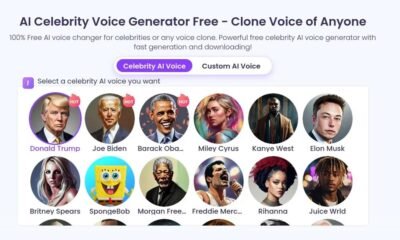Technology
Understanding the Risks of Generative AI in the Workplace
Published
2 years agoon
By
Admin
Advanced technologies like GPT-4, a type of AI, are quickly changing workplaces around the world. These AI tools help in many ways, from speeding up content creation to improving customer service.
While there are risks with using AI, it’s important to understand and address these issues so that AI can be used in a helpful and responsible way at work. Let us help you learn how to use AI effectively and safely!
The Power of Generative AI
Generative AI is a smart technology that can create different things like text, images, and music by learning from data it finds online. This technology is really helpful for businesses in several ways:
- Creating Content: AI can write articles, reports, and social media posts automatically, which saves a lot of time and work.
- Helping Customers: AI can make chatbots and virtual assistants that answer tough questions, making customer service quicker and better.
- Designing Products: AI helps create new designs and prototypes, leading to cool and innovative products.
Even though these benefits are great, knowing the risks is important, too. By understanding these risks, you can use generative AI effectively and avoid any problems.
Ethical and Legal Challenges in Generative AI
Bias and Discrimination
Generative AI uses data to learn and create new things. But sometimes, this data can have hidden biases or unfairness. If we don’t fix these, the AI might continue to be unfair. For example, if an AI program for hiring learns from data that favors a certain group, it might unfairly favor that group when choosing candidates.
Intellectual Property Issues
AI can sometimes create artwork or music that looks or sounds very similar to existing works. This can lead to problems with intellectual property, which means who legally owns the work. If an AI creates something too much like an existing piece, it might be seen as copying or stealing, which can cause legal trouble.
Misinformation and Deepfakes
AI can create fake content, such as news articles or videos that look unreal. These are called deepfake videos. Deepfakes can spread false information and trick people, causing harm. For example, a fake news story made by AI could damage a company’s reputation or mislead the public.
The Security Risks of Using Generative AI
Here are some security risks you and your team should know about when using generative AI in your workplace.
-
Data Privacy
Generative AI models need large amounts of data to learn and work well. This data might include private and sensitive information. It’s really important to keep this data safe and anonymous so that it doesn’t get leaked. This helps protect people’s personal information and maintains their trust.
-
Cybersecurity Threats
Hackers and cybercriminals can use AI to create harmful content like fake emails phishing or malicious software malware. If they manage to break into an AI system, they can make it do harmful things, which puts your company’s security at risk.
-
Job Displacement
While AI can make work faster and more efficient, it also raises concerns about people losing their jobs. AI can do tasks that humans used to do, which might reduce job opportunities. It’s important for businesses to introduce AI carefully and make sure their employees get the training they need to work alongside AI.
Operational Challenges
Here are some of the operational challenges that businesses face.
1. Integration Issues
Incorporating AI into workflows and systems can pose challenges in terms of complexity and expenses. It involves modifications to infrastructure and procedures along with the need to train employees on the utilization and supervision of AI tools.
2. Quality Control
Ensuring the precision and caliber of content generated by AI poses another hurdle. Although AI can swiftly generate content, it frequently lacks the comprehension of human creators, highlighting the need for a thorough review and stringent quality assurance processes.
The Role of Proxies in Mitigating Risks
Using proxies is important when dealing with the dangers linked to generative AI. Businesses can improve their data privacy and security by utilizing proxies. For example, proxies help mask the data used for training AI models, thus lowering the chances of exposing information.
Moreover, proxies make it easier to conduct secure and effective web scraping for gathering training data while ensuring adherence to ethical guidelines.
A reliable proxy provider like Go Proxies offers a range of solutions tailored to different needs, including residential, data center, and mobile proxies.
Best Practices for Using AI Responsibly
To use generative AI safely and effectively, businesses should follow these best practices:
- Regular Audits: Regularly check your AI systems. This helps you spot problems, like biases or ethical issues, early on and fix them quickly.
- Strong Security Measures: Make sure you have strong security measures in place. This means protecting your data carefully and preventing any cyber threats. It’s important to keep information safe and private.
- Follow the Law: Ensure that anything created by AI, like articles or designs, follows intellectual property laws and other rules. This helps you avoid legal troubles and respect other people’s work.
- Train Your Employees: Offer training programs to help your employees adapt to AI technologies. This helps them feel confident and ready to take on new tasks and roles as technology changes.
- Be Transparent: Always be open about how your AI works. Explain how you use data and how decisions are made. This builds trust with your customers, employees, and other stakeholders.
Conclusion
Generative AI has the power to revolutionize workplaces. Nonetheless, it carries risks.
Businesses can harness AI responsibly and efficiently by recognizing and tackling these risks. Employing resources, like proxies offered by providers like Go Proxies, can boost data protection and streamline operations, aiding organizations in managing the challenges of AI integration. With strategizing and proactive oversight, generative AI can become an asset in today’s work environment.


Nolan Pentz Martinez: The Son of Nona Gaye Who Walks His Own Path

Yado Yakub The Marine, Lawyer, and Husband of Margaret Brennan

Who is Chinua Shakur? The Shakur Family’s Hidden Gem

Lily Radford: The Secret Life of Karen Grassle’s Daughter

What’s Happening in the UK That’s Pushing People Toward the UAE

Maximizing Savings with a Commercial Energy Efficiency Consultant

Meet Nicola Elizabeth Frost: The Woman Behind Tom Holland’s Success

The Ultimate Guide to Choosing the Perfect Body Moisturiser for Radiant Skin

Miles Xavier Tate: The Quiet Son of Hollywood’s Larenz Tate

General News LogicalShout: The Smarter Way to Stay Informed

Revolutionizing Healthcare: The Emergence of AI-Driven Analytics

Carol Kirkwood’s Journey: Her Real Age, Husband, Career, and More

How Machine Learning and AI are Redefining the Future?

Aliza Barber: Meet Lance Barber’s Wife, Age, Life, Profile, Career and Net Worth

Evelyn Melendez: Jordan Knight’s Wife Bio, Marriage, Family, Career and Net Worth

Ilan Tobianah Biography: Family, Marriage, Lifestyle, Career and Net Worth

King Von’s Autopsy Report: The Truth Behind the Tragic Death

Who was Alice Marrow? Everything to Know About Ice-T’s and His Mother

Body Positivity and Bodycon: Embrace Your Shape with Homecoming Dresses

Meet Otelia Cox: The Supportive Wife of Tony Cox – A True Fairy Tale Romance

Nolan Pentz Martinez: The Son of Nona Gaye Who Walks His Own Path

Yado Yakub The Marine, Lawyer, and Husband of Margaret Brennan

Who is Chinua Shakur? The Shakur Family’s Hidden Gem

Lily Radford: The Secret Life of Karen Grassle’s Daughter

What’s Happening in the UK That’s Pushing People Toward the UAE

Maximizing Savings with a Commercial Energy Efficiency Consultant

Meet Nicola Elizabeth Frost: The Woman Behind Tom Holland’s Success

The Ultimate Guide to Choosing the Perfect Body Moisturiser for Radiant Skin

Miles Xavier Tate: The Quiet Son of Hollywood’s Larenz Tate

General News LogicalShout: The Smarter Way to Stay Informed
Category
Trending
-

 Health2 years ago
Health2 years agoRevolutionizing Healthcare: The Emergence of AI-Driven Analytics
-

 News5 months ago
News5 months agoCarol Kirkwood’s Journey: Her Real Age, Husband, Career, and More
-

 Technology2 years ago
Technology2 years agoHow Machine Learning and AI are Redefining the Future?
-

 Celebrity2 years ago
Celebrity2 years agoAliza Barber: Meet Lance Barber’s Wife, Age, Life, Profile, Career and Net Worth


